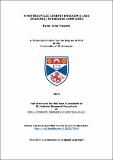Files in this item
N-heterocyclic carbene rhodium(I) and iridium(I) hydroxide complexes
Item metadata
| dc.contributor.advisor | Nolan, Steven P. | |
| dc.contributor.author | Truscott, Byron John | |
| dc.coverage.spatial | xv, 193 p. | en_US |
| dc.date.accessioned | 2015-07-28T12:26:45Z | |
| dc.date.available | 2015-07-28T12:26:45Z | |
| dc.date.issued | 2014 | |
| dc.identifier | uk.bl.ethos.658922 | |
| dc.identifier.uri | https://hdl.handle.net/10023/7049 | |
| dc.description.abstract | The unique reactivity that hard/soft-acid/base mismatched metal hydroxide complexes are capable of makes this elusive class of highly reactive organometallic complexes very interesting. The stabilisation of rhodium and iridium hydroxide bonds using electron rich N-heterocyclic carbene (NHC) ligands has enabled us to examine their rich chemistry and proved to be very rewarding. A general method was established for the preparation of a family of Rh(I)-NHC hydroxide complexes (four members), which proved to be highly active promoters of the conjugate addition of arylboronic acids to α,β-unsaturated ketones, achieving TONs and TOFs of 100,000 and 6,600 h⁻¹ respectively. In addition, we have studied the activity of Rh(I)-NHC hydroxides in catalysing the hydrosilylation and dehydrogenative silylation of terminal alkenes. The two competing reactions were studied under the same conditions and a scope for each transformation with good selectivity is presented. The scope of metal hydroxides was extended to include Ir(I)-NHC hydroxides (six members). Reactivity of this motif towards a wide range of organic substrates has been explored, undergoing reaction with arylboronic acids to form Ir(I)-aryl complexes and reacting with silanes to form Ir(I)-siloxides. The Ir(I)-hydroxide is able to deprotonate an array of O-H and N-H bonds to give new Ir(I)-alkoxides and Ir(I)-amides. In addition, C-H activation of a range of sp-, sp²- and sp³-hybridised carbon centres has been explored, delivering Ir(I)-alkyl complexes under very mild conditions, with the generation of H₂O as the sole by-product. Subsequently, we have examined the insertion of CO₂ into a number of Ir(I)-O and Ir(I)-N bonds, leading to Ir(I)-carbonates and Ir(I)-carbamates, respectively. In the case of reaction between CO₂ and Ir(I)-hydroxide, a fascinating [{Ir(I)}₂-(µ-κ¹O:κ²O,O-CO₃)] complex was obtained under extremely mild conditions. This reaction has been studied in detail using kinetic and theoretical methods to calculate activation parameters and elucidate the insertion and concomitant dimerisation mechanism. In addition, we have utilised a series of methods for the preparation of a range of interesting fluorinated Rh(I)-NHC and Ir(I)-NHC complexes; bearing fluoride, bifluoride and trifluoromethyl groups. We disclose the first iridium bifluoride complexes and briefly discuss the relationship between these and the fluoride species in solution. We also report the first Ir(I)-NHC and Rh(I)-NHC trifluoromethyl complexes. | en_US |
| dc.language.iso | en | en_US |
| dc.publisher | University of St Andrews | |
| dc.subject.lcc | QD181.R5T8 | |
| dc.subject.lcsh | Rhodium compounds | en |
| dc.subject.lcsh | Iridium compounds | en |
| dc.title | N-heterocyclic carbene rhodium(I) and iridium(I) hydroxide complexes | en_US |
| dc.type | Thesis | en_US |
| dc.contributor.sponsor | Engineering and Physical Sciences Research Council (EPSRC) | en_US |
| dc.contributor.sponsor | European Research Council (ERC) | en_US |
| dc.type.qualificationlevel | Doctoral | en_US |
| dc.type.qualificationname | PhD Doctor of Philosophy | en_US |
| dc.publisher.institution | The University of St Andrews | en_US |
This item appears in the following Collection(s)
Items in the St Andrews Research Repository are protected by copyright, with all rights reserved, unless otherwise indicated.

